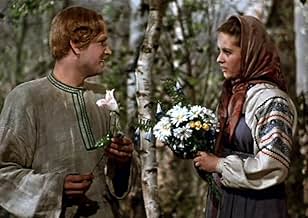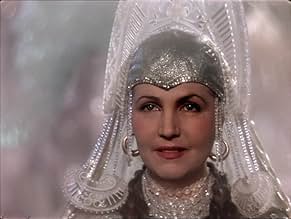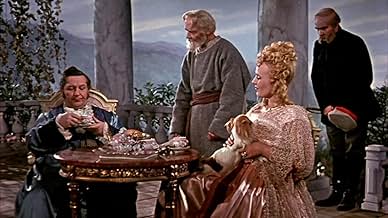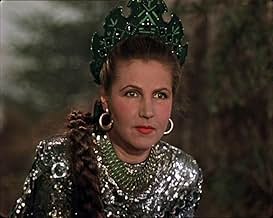IMDb RATING
7.1/10
558
YOUR RATING
Obsessed with perfecting his craft, young gemcutter Danilo visits the mystical Copper Mountain to uncover the secret behind its infamous attraction - the Stone Flower, a stone carving so cap... Read allObsessed with perfecting his craft, young gemcutter Danilo visits the mystical Copper Mountain to uncover the secret behind its infamous attraction - the Stone Flower, a stone carving so captivating that no one can leave after seeing it.Obsessed with perfecting his craft, young gemcutter Danilo visits the mystical Copper Mountain to uncover the secret behind its infamous attraction - the Stone Flower, a stone carving so captivating that no one can leave after seeing it.
- Director
- Writers
- Stars
- Awards
- 2 wins & 2 nominations total
Vladimir Druzhnikov
- Danilo - master
- (as V. Druzhnikov)
Yekaterina Derevshchikova
- Katya
- (as Y. Derevshchikova)
Mikhail Troyanovskiy
- Prokopych
- (as M. Troyanovsky)
Mikhail Yanshin
- Severyan
- (as M. Yanshin)
Nikolay Temyakov
- Barin
- (as N. Temyakov)
Anna Petukhova
- Barina
- (as A. Petukhova)
Nikolai Orlov
- Stary master
- (as N. Orlov)
Lidiya Deikun
- Vikhorika
- (as L. Deikun)
Serafim Zaytsev
- Yefimka
- (as S. Zaytsev)
Vitaliy Kravchenko
- Danilo - malchyk
- (as V. Kravchenko)
- Director
- Writers
- All cast & crew
- Production, box office & more at IMDbPro
Featured reviews
For the commentator below, I thought I had seen it on tape but I'm not sure. Most probably saw it an art house in Chicago or some university festival (Roosevelt University had a very good one back then).
The film's use of color was a landmark breakthrough. It was a process different and superior to technicolor. We can do it today in say, Kodacolor, and "The Red Shoes" did indeed quite approximate it but good as that was, it did not equal SF,
I wonder if Martin Scorcese, who did a commentary for "The Red Shoe" saw it. I'm sure he would have been impressed and if someone could get to him today he might even promote putting it on DVD just for gras artis gras.
The film was of some importance politically too in that it was the first kind of cultural exchange gesture the Soviets made at the height of the cold war. We probably sent them "Gone With The Wind." I mean that.
The film's use of color was a landmark breakthrough. It was a process different and superior to technicolor. We can do it today in say, Kodacolor, and "The Red Shoes" did indeed quite approximate it but good as that was, it did not equal SF,
I wonder if Martin Scorcese, who did a commentary for "The Red Shoe" saw it. I'm sure he would have been impressed and if someone could get to him today he might even promote putting it on DVD just for gras artis gras.
The film was of some importance politically too in that it was the first kind of cultural exchange gesture the Soviets made at the height of the cold war. We probably sent them "Gone With The Wind." I mean that.
So says the grizzled old factory watchman at the conclusion of the folk tale he's been telling the children huddled around his fire through the Russian night. One of the young boys comes quietly up to him as the others leave, and tells him that he too wants to be a master-stoneworker, like the hero of the story: "ah!", says the watchman, "you got the point!" And the point's not just for children, either.
Ptushko's memorably beautiful film makes for a gripping parable about the conflict between the inner and outer life of the born artist, willing to risk sacrificing everything - even the woman he loves - in pursuit of artistic and technical perfection. At the secret heart of the Copper Witch's caverns, the Stone Flower itself represents that unattainable ideal of beauty, natural material fashioned so cunningly that it seems more real than reality itself. Danila, deeply unsatisfied with his work admired though it is by so many, has to study its form at any price, leaving his betrothal feast to pursue his ideal and hone his technique.
Will Danila break free of the Copper Witch's charms, and return to the "real world"? You'll have to watch the film to find out...
With only four significant characters - the young genius, the ageing and ailing master-craftsman who teaches (or is taught by) him, his faithful betrothed Katinka, and of course the Copper Witch herself - "Kamennyy tsvetok" is much more tightly structured and less riotously inventive than some of the other Ptuchko films I've been privileged to see, and the tension never flags.
Political content, too, is restrained - surprisingly so, given the film's date and the fact that it was (as other commentators have pointed out) the first major Russian film to be made in colour. The peasants are duly repressed by the fat and frivolous landowners and their brutal class-traitor henchmen, but (assuming that *my* brain has figured it out correctly!) the clear message is that whatever its conflicts with everyday life and relationships, art certainly transcends politics and class. Surprising indeed. There's even a moment in the beautifully depicted and choreographed folk betrothal where religious icons are bowed to with grace and reverence. It is amazing that Ptushko was daring enough to try to get that one past the censors, let alone manage to succeed!
The commentator who compared the visual feast on offer with Powell and Pressburger's roughly contemporary "The Red Shoes" was spot on: their "Tales of Hoffmann" is even closer in spirit. Ptushko's visual imagination and daring are in that league, and his colour process produced really breathtaking pictures. If his images here seem more illustrative and pictorial, less intrinsically filmic than the art of those English masters, they are none the less memorable. The magic scenes in the woods, and in the gem-sparkling caverns, are of a loveliness seldom matched in film of any era, and never surpassed.
The currently available RUSCICO DVD version is quite beautifully restored visually, and the sound is very acceptable too. With good extras, including a half-hour feature about Ptushko's life and work showcasing extracts from many of his other films, why not treat yourself and your family, if you have one, to this rich folk-tale? If you respond to it as I did, you may even manage - for one brief, shining moment - to feel that you are nine years old once again!
Ptushko's memorably beautiful film makes for a gripping parable about the conflict between the inner and outer life of the born artist, willing to risk sacrificing everything - even the woman he loves - in pursuit of artistic and technical perfection. At the secret heart of the Copper Witch's caverns, the Stone Flower itself represents that unattainable ideal of beauty, natural material fashioned so cunningly that it seems more real than reality itself. Danila, deeply unsatisfied with his work admired though it is by so many, has to study its form at any price, leaving his betrothal feast to pursue his ideal and hone his technique.
Will Danila break free of the Copper Witch's charms, and return to the "real world"? You'll have to watch the film to find out...
With only four significant characters - the young genius, the ageing and ailing master-craftsman who teaches (or is taught by) him, his faithful betrothed Katinka, and of course the Copper Witch herself - "Kamennyy tsvetok" is much more tightly structured and less riotously inventive than some of the other Ptuchko films I've been privileged to see, and the tension never flags.
Political content, too, is restrained - surprisingly so, given the film's date and the fact that it was (as other commentators have pointed out) the first major Russian film to be made in colour. The peasants are duly repressed by the fat and frivolous landowners and their brutal class-traitor henchmen, but (assuming that *my* brain has figured it out correctly!) the clear message is that whatever its conflicts with everyday life and relationships, art certainly transcends politics and class. Surprising indeed. There's even a moment in the beautifully depicted and choreographed folk betrothal where religious icons are bowed to with grace and reverence. It is amazing that Ptushko was daring enough to try to get that one past the censors, let alone manage to succeed!
The commentator who compared the visual feast on offer with Powell and Pressburger's roughly contemporary "The Red Shoes" was spot on: their "Tales of Hoffmann" is even closer in spirit. Ptushko's visual imagination and daring are in that league, and his colour process produced really breathtaking pictures. If his images here seem more illustrative and pictorial, less intrinsically filmic than the art of those English masters, they are none the less memorable. The magic scenes in the woods, and in the gem-sparkling caverns, are of a loveliness seldom matched in film of any era, and never surpassed.
The currently available RUSCICO DVD version is quite beautifully restored visually, and the sound is very acceptable too. With good extras, including a half-hour feature about Ptushko's life and work showcasing extracts from many of his other films, why not treat yourself and your family, if you have one, to this rich folk-tale? If you respond to it as I did, you may even manage - for one brief, shining moment - to feel that you are nine years old once again!
This faux (?) folktale, probably the best known film of Soviet fabulist Aleksandr Ptushko, is a paean to artistic individuality: a daydreaming youth becomes protégé to an old stone carver; visits the secret cave of a mountain witch to delve into his art; and then, with the unwavering trust of his deserted bride, finds his way back into the world as absolute master of his craft. A rather non-collective idea to find in the Stalinist film world of the time. Ptushko's style often looks like some over-decorated/Russian-themed Christmas window, but it certainly fits his subject. The crudity in the technique comes off as sincerity and the USSR color processing of the era is often quite lovely if you boost the brightness level on your equipment. Aimed at kids, but probably best for grown up cultural Sovietologists.
NOTE: Check out the DVD extras for an amazing stop-motion animation clip from Ptsuhko's 1936 pic THE NEW GULLIVER.
NOTE: Check out the DVD extras for an amazing stop-motion animation clip from Ptsuhko's 1936 pic THE NEW GULLIVER.
I saw The Stone Flower as somebody who really liked some of Aleksandr Ptusko's other films like Ruslan and Ludmilla, Sampo and Sadko(which is only to be seen in the original Russian version, the dub ruins it), and is having a great run of Russian fairy/folk-tale films. It was also highly recommended by commentators for those respective films, regarding it as one of his best/one of their favourites of his. I am happy that there are people who remember The Stone Flower very fondly, I am one of those newly-acquainted with it from Youtube rather than those who saw it in childhood. I am also glad that I saw it, as it really is as good as people say it is, and for me it is one of Ptushko's best. It is a gorgeous film to look at, the scenery is enough to take your breath away and the film is beautifully shot as well. It is very easy to be taken by the music score as well, because it does have a sense of fantasy and adventure, it sounds very Russian in its songs and its nationalistic feel, it is lusciously orchestrated and sometimes even sounds like a tender tone poem. The dialogue is well-incorporated within the story and sounds generally natural and sincerely delivered. The story is a magical one, it unfolds beautifully and packs a very powerful punch. It does move slowly particularly in the middle, but that is not a bad thing, if anything it gave the story a sense of freedom, time to breathe and allowed us to become invested in the characters and story and also admire the Russian culture. The characters all engage, especially the wicked Copper witch, they are fairy-tale clichés certainly but that is not to be taken as a bad thing. The acting is good, the hero is noble and sincere and the Copper Witch is both entrancing and icy. I personally didn't see the ending as that much of a cheat, there have been far worse ending cheats around. Though I do think also that The Stone Flower perhaps could've been even more powerful if ended tragically. All in all, magical. 10/10 Bethany Cox
Seen shortly after it was released. A beautiful, and apparently rare film, since I have never seen a video of it available. Easily equal to the work of Serge Eisenstein, produced during the Stalinist days of the USSR, but is a telling of a famous Russian fable. An excellent film, which should be on video.
Did you know
- ConnectionsFeatured in Adieu l'URSS! (2021)
Details
- Release date
- Country of origin
- Language
- Also known as
- The Stone Flower
- Filming locations
- Production company
- See more company credits at IMDbPro
- Runtime1 hour 29 minutes
- Sound mix
- Aspect ratio
- 1.37 : 1
Contribute to this page
Suggest an edit or add missing content


























